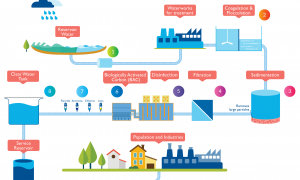🕑 Reading time: 1 minute
Roughening devices are installed at the downstream end of the channel and their main function is to dissipate energy from water flow coming on to the downstream bed. Different types of roughening devices generally used are friction blocks, biff walls, arrows, dentated sills, deflectors, ribbed pitching etc.
In general, cisterns with impact are responsible for energy dissipation in canal falls but in the case of inclined impact cistern and no impact cisterns roughening devices become a necessary installation. These devices work on the basis of the turbulence of flow and boundary friction developed with the flow.
Contents:
Types of Roughening Devices
1. Dentated sill
Dentated sill is nothing but a projection of floor with dents provided at the end of a cistern to dissipate the energy of water jet coming downwards. It is provided where high-velocity flow continues till the end of a cistern. Whenever the flow enters, it cuts the flow into a number of jets thus dissipating the energy.

2. Deflectors
A deflector is also a projection at the end of cistern like dentated sill, but it is of uniform height and its function is to deflect the flow and to create a hydraulic jump near the bed. When the flow strikes the deflector it gets deflected and thus the residual energy gets dissipated. The deflector is also called as a baffle wall.

3. Biff wall
The biff wall is a modified version of the baffle wall. It is also provided at the end of the cistern in the form of a projection from the floor. But here, the top surface of the projection is designed in such a way that it should protect the toe of the

4. Staggered Friction blocks
Staggered friction blocks are made of concrete generally fixed to the downstream bed floor. These are widely used roughening devices because of their effective working and simple construction. When water flows through these blocks, they cut the stream into a number of sections
They are rectangular in shape and the height of friction blocks is generally about 1/4th of the water depth. These blocks are kept at a distance twice of their height.

5. Arrows
Arrows are also friction blocks which are provided on the downstream floor of the channel. What differs arrows from normal friction blocks is their shape. Arrows are specially shaped friction blocks which are more effective than normal friction blocks in the dissipation of energy.

6. Ribbed Pitching
In case of ribbed pitching, the canal bed and side slopes on its downstream side are provided with brick layered pitching. It consists of alternately laid bricks - one showing its edge abutting another one showing its end as showing in the figure below. It is also called cellular pitching.
When the flow reaches downstream and meets ribbed pitching, friction develops and the surplus energy created by flow is dissipated.



